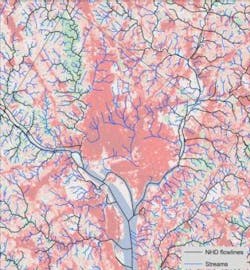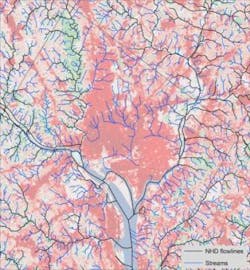Mapping technique helps assess impact of urbanization on aquatic ecosystems
FROSTBURG, MD, Oct. 2, 2013 -- A new method to better discern where streams begin has been developed by researchers from the University of Maryland Center for Environmental Science, resulting in a new map of the Potomac River watershed stream network that significantly improves the information needed for assessing the impact of urbanization on aquatic ecosystems.
The researchers developed a high-resolution map of streams in the Potomac River watershed and five smaller Maryland watersheds, an area that spans from the Appalachian Mountains to the Chesapeake Bay and includes the metropolitan areas of Baltimore, Md., and Washington, D.C. The maps show streams that still flow through forests and fields, as well as predicts the location of streams that have been buried through development and agricultural use.
"For the first time, we have an accurate representation of where streams once flowed through major urban areas of Baltimore and Washington, D.C. and where streams currently flow through forests," said the study's lead author Dr. Andrew Elmore of the University of Maryland Center for Environmental Science's Appalachian Laboratory. "This information is critical for quantifying the impact of urbanization on aquatic ecosystems."
Urbanization results with the land being covered by hard, or impervious, surfaces that prevent soil from absorbing water and pollutants. Water instead moves quickly as "runoff," picking up large amounts of sediment and pollution along the way and delivering it to streams and major bodies of water, such as the Chesapeake Bay. This leads to decreased water quality that can impact the health of vegetation, wildlife and humans that come into contact with it.
Many small streams are not included in previous maps either because they were buried during the course of urban development or because they were smaller than the minimum mapping size at the time of map generation. The location of streams influences land use decisions through the impact of surface water on the cost of developing land and on forest and agricultural productivity. These "missing streams" cause a major problem for efforts to form regulatory policy intended to protect streams.
"High-quality maps of natural resources, including streams, is a prerequisite to sustainable development," said Elmore. "However, such maps do not currently exist for large areas, severely limiting our ability to understand, protect, and restore the ecological functioning of these natural assets."
In the U.S., land use decisions are made with regard to stream presence using the National Hydrology Dataset (NHD), a map of surface water including rivers, streams and lakes that is available to all levels of government and the public. The researchers found that these maps underrepresent total stream density in the Potomac River region by as much as 250 percent. This underrepresentation is sometimes due to urbanization that occurred prior to the original stream maps being generated. However, even within forested watersheds, the study found a wide variability in accuracy due to outdated mapping techniques.
To account for "missing streams," the researchers collected field data on stream occurrence in forested areas of the watershed and related it to several landscape variables that correlate with the presence of streams. This relationship allowed the researchers to project the probability of streams back onto the landscape, mapping the potential of where they would be located in the absence of urban development or agriculture. This potential stream map can be used to determine how land use changes have impacted the number and length of streams in the watershed.
"We intend our results to advance ongoing research by providing a useful high-resolution stream map for this region and a new methodology for future applications in other regions," said Elmore.
The study, "Potential Stream Density in Mid-Atlantic U.S. Watersheds" is published in the August issue of PLOS One by Andrew Elmore, Steven Guinn, and Matthew Fitzpatrick of the University of Maryland Center for Environmental Science, and Jason Julian of Texas State University.
###

